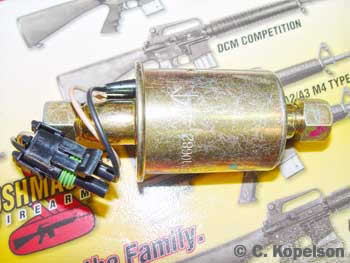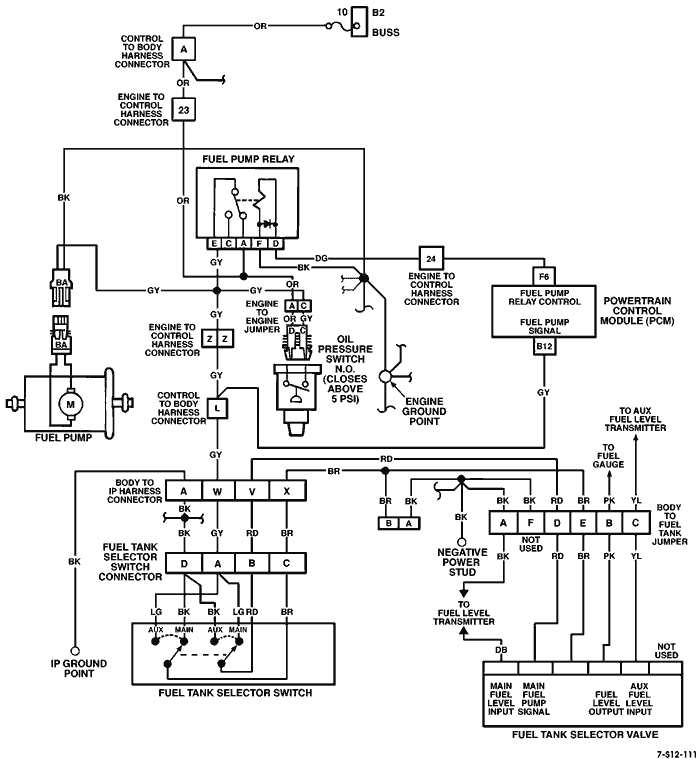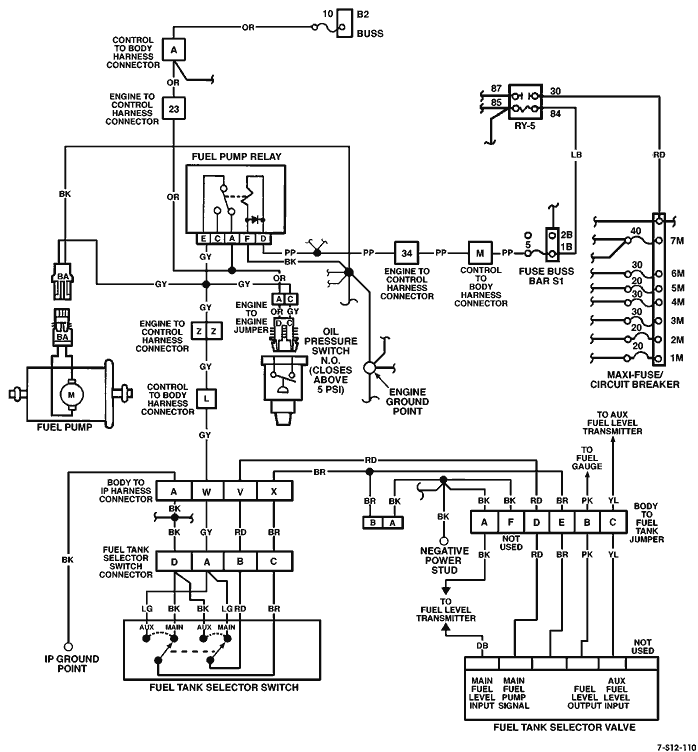Trouble Shooting the Lift Pump
Updated September 21, 2009
Circuit Diagrams from AM General Shop Manual
 Lift pumps were throw away replaceable Items on a Hummer. My 98 truck has probably gone through 4, although the last one has lasted 9 years so maybe they have been improved. The picture on the left is an installed view from the rear with the engine cover removed. The pumps are standard (see below) that cost about 70 dollars. The only difference between the factory pump and the aftermarket one is the electrical connector. I keep a spare pump and a fuel filter in my truck at all times.
Lift pumps were throw away replaceable Items on a Hummer. My 98 truck has probably gone through 4, although the last one has lasted 9 years so maybe they have been improved. The picture on the left is an installed view from the rear with the engine cover removed. The pumps are standard (see below) that cost about 70 dollars. The only difference between the factory pump and the aftermarket one is the electrical connector. I keep a spare pump and a fuel filter in my truck at all times.
The oil pressure sending switch supplies power to the pump (pre 99) through a relay so check them also. When you replace the pump you might want to replace the "O" rings on the fuel fittings The AMG service manual mentions to replace them. However the AMG parts manual only lists an AMG part number and not the dimensional size of the "O" rings. I used 3/8" ID, 9/16 OD with 3/32 thickness.
 As for the Oil Pressure Switch (see picture), any AC Delco outlet can supply one for any GMC 2500 6.5 truck. Note: I believe that trucks made from 1999 and newer do not have oil pressure switch cutoffs built into the pressure switch. The pump is controlled by the computer.
As for the Oil Pressure Switch (see picture), any AC Delco outlet can supply one for any GMC 2500 6.5 truck. Note: I believe that trucks made from 1999 and newer do not have oil pressure switch cutoffs built into the pressure switch. The pump is controlled by the computer.
You know the pump is running because it makes a distinct clicking noise. If the clicking sound starts to change pitch and get louder your pump may be on it's way out. The truck will run with a burned out pump because the injection pump will suck fuel all the way from the fuel tank as long as the fuel line and all it's components are air tight. You might experience some loss of power, but not all the time.
You are probably asking yourself, why all the bother with cutting off the fuel pump when you lose oil pressure if that won't stop the engine? The cutoff isn't to protect the engine, it's to protect you from fire if you are in an accident. It guarantees that the fuel pump will stop pumping fuel where it could be dumped all over the engine compartment after an accident.
Alternate pumps
ACDelco EP-158
Borg-Warner 19 EP-7288
Federal-Mogul (Carter) P74001$74.41 (Dec. 2003)
NAPA P74001
Standard EFP-281
1. Unplug the two wire connector for the fuel pump.
2. With a voltmeter connected to the two pins on the supply (truck) side, turn the key to crank. If you read 12V then the supply side fuse and fuel pump relay are OK.
3. Next start the engine cold. After the engine reaches the typical cold maximum oil pressure (usually 55 PSI) immediately switch off the engine (you should run the engine for about a minute, or less). You should continue to read 12V for a short period of time as the oil pressure falls. An engine that holds good oil pressure will take about five seconds to fall to zero. If the 12V is missing in this step, and not in step 2 above, then the oil pressure switch is bad (common failure).
4. Take the fuel pump side of the connector, with the engine off, key off. There should be one gray (or brown) wire and one black wire. Ground the black wire with a short jumper. Next connect the other wire to a 12V source. An easy to use source is the CTIS fuse which is at 12V unswitched. If the pump fails to run (you'll hear it) then replace the pump.
I had a problem and it turned out to be a bad wire in the harness that supplied power to the circuit. AMG had problems with windshield wiper fluid getting into the harness and corroding connections on my 98. There is also a small relay that actually powers the fuel pump. Check to see that it's working. I believe that it's located near the pump.
One last tip: I finally figured out that if you turn the wheels to the right all the way there is enough room inboard of the left front tire to stand right up against the firewall and not have to kneel on the tire and lean over the engine compartment when working on the pump.

Many of the pumps will run but not pump enough fuel. If the pump runs then take the fuel line off of the pump and see if you get a good strong stream of fuel to pump into a container. If you have a pressure gauge you should get 8psi,(after the filter) which is over the 4psi minimum. In 15 seconds it should pump out about 16oz, but at least the 8oz minimum. If you get a good stream of fuel coming out of the fuel filter line which goes to the injection pump you are probably ok.
If it is a turbo engine the sender is located under the intake (requires removal of the dog house to get at in that case.) A non-turbo engine has the oil pressure switch located on the side of the block, above the oil filter (next to the oil cooler lines). Can be changed from below, but it's a bit of a reach.
Bleed Air
If you do open up the fuel system you may have to purge the air out of the system. Run the fuel pump (turn the key to start) and open up the black dial/valve on top of the fuel filter to bleed out air. If the engine won't start loosen one injector feed line on each side of the engine and crank the engine. This will bleed air out of the injector pump. The engine should start. Let the air bleed. It might look like foamy fuel. Then retighten the lines.
Remember; DO NOT crank the engine for extended periods or you will burn out your starter and drain your battery. Crank for 10 seconds at a time and let the starter cool off for a minute.

97 Turbo Circuit

N/A Diesel Circuit
Circuit diagrams are from the 1997 AMG Shop Manual
Drain filter light flickers or stays on
Drain off enough fuel through the petcock to fill a drinking glass. Let it sit for 30 minutes and visually inspect to determine if you have water and fuel in the glass. The two will separate and you will see 2 "layers". If that is true, you have water in your fuel ( use a gas station with a high usage of diesel or better yet a truck stop). If you don't have a visible separation of fuel and water in the glass, you may have a fuel filter sensor going bad.

